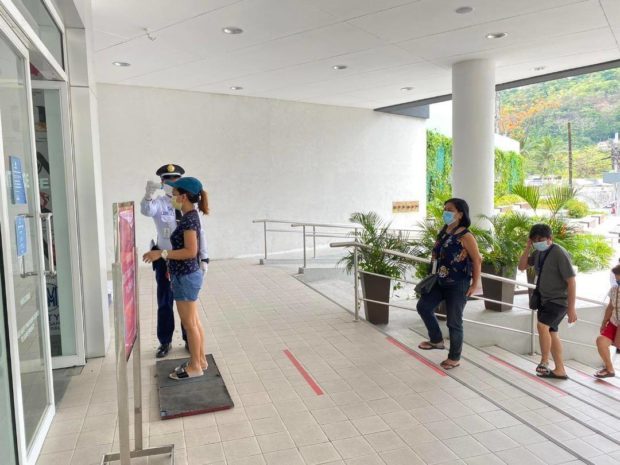
THERMAL SCAN Customers entering a mall in Olongapo City observe social distancing and undergo thermal scanning as preventive measures against the spread of the new coronavirus disease, as the city eases into general community quarantine on Sunday. CONTRIBUTED PHOTO
OLONGAPO CITY, Zambales, Philippines — A day before the city transitioned into a general community quarantine (GCQ), an 18-year-old woman who just gave birth at the hospital here contracted the new coronavirus disease (COVID-19).
Many local officials feared that the case would lead to a rise in COVID-19 cases in their communities as they relaxed quarantine regulations.
The woman gave birth at James L. Gordon Memorial Hospital on April 26, and her case, according to Mayor Rolen Paulino Jr., illustrated how the residents could remain vulnerable to the spread of the virus with the city under GCQ till May 31.
“Everyone in Olongapo must cooperate and resist the urge to go out of their home. It is only with the collective discipline and effort of everyone that we can effectively deal with the crisis,” Paulino said.
Also in Zambales, three villages in Subic town were placed on total lockdown from Saturday to Monday after two residents contracted the virus. The new infections surfaced as the province shifted to a modified enhanced community quarantine (MECQ).
Nurses infection
In Baguio, a 32-year-old nurse at Baguio General Hospital and Medical Center became the first COVID-19 patient after the city eased into GCQ.
Mayor Benjamin Magalong has ordered immediate contact tracing and strict implementation of quarantine and disinfection protocols, including the possible lockdown of affected areas.
In Naga City, Camarines Sur province, the village of San Francisco was placed on total lockdown on Saturday until May 30 after a nurse tested positive for COVID-19. Naga has adjusted its quarantine restrictions.
Mayor Nelson Legacion said the immediate members of the nurse’s family were already brought to the city-controlled isolation facility and movement restrictions had been imposed in her village.
Very high-risk areas
In Davao City, which also eased into GCQ, Mayor Sara Duterte warned people against going to “very high-risk areas,” such as the villages of 13-B, 21-C, 23-C, Buhangin proper and Leon Garcia, which recently showed an outbreak of cases, and the Bankerohan and Agdao public markets.
Speaking on the city-run Davao City Disaster Radio on Sunday, Duterte said GCQ conditions could trigger more COVID-19 cases because more people would be allowed outside of their homes.
Duterte told residents to still avoid going to the malls, banks, hospitals, churches and all other areas where people could meet or congregate because of higher risk of getting the virus.
A lockdown remains an option for the city government once the area registers more cases, she said.
“We still need to be vigilant because there is no vaccine, yet and the disease is still around,” Duterte said. “That’s why we still need the [measures under the] new normal, the self protection measures.”
More testing centers
Other local governments have fast-tracked the setting up of testing centers as they moved into ECQ.
At least two PCR (polymerase chain reaction) testing facilities will open this week at Northern Mindanao Medical Center and at the tuberculosis reference center of the Department of Health (DOH) office in Northern Mindanao.
Dr. Adriano Suba-an, DOH regional director, said the testing centers, both located in Cagayan de Oro City, would be using the real-time PCR machines purchased by the city government.
Once operational, the DOH center would cater to the testing needs of other areas in Mindanao, such as parts of Lanao del Norte, Zamboanga del Norte, Zamboanga del Sur and provinces in the Caraga region.
Cagayan de Oro Mayor Oscar Moreno said his city would join those in Davao and Zamboanga as the centers for COVID-19 testing in Mindanao.
In southern Luzon, new testing facilities were set up in Palawan and Quezon provinces.
Ospital Ng Palawan in Puerto Princesa City became the first COVID-19 testing center for Mimaropa region, which will start this Monday, according to Dr. Mario Baquilod, DOH regional director.
In Albay, Bicol Regional Diagnostic and Reference Laboratory at Bicol Regional Training and Teaching Hospital in Legazpi City temporarily suspended COVID-19 tests after Typhoon “Ambo” (international name: Vongfong) damaged one of its facilities last Friday.
Dr. Ernie Vera, DOH director for Bicol, said 146 tests that were pending at the region’s lone COVID-19 laboratory were redirected to the Research Institute for Tropical Medicine in Manila.
—REPORTS FROM JOANNA ROSE AGLIBOT, GREG REFRACCION, STEPHANIE FLORIDA, JIGGER J. JERUSALEM, ROMAR MIRANDA, DELFIN T. MALLARI AND REY ANTHONY OSTRIA

